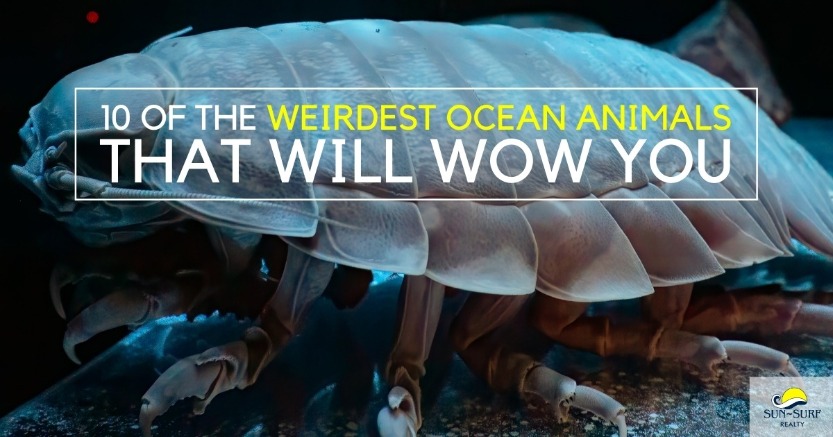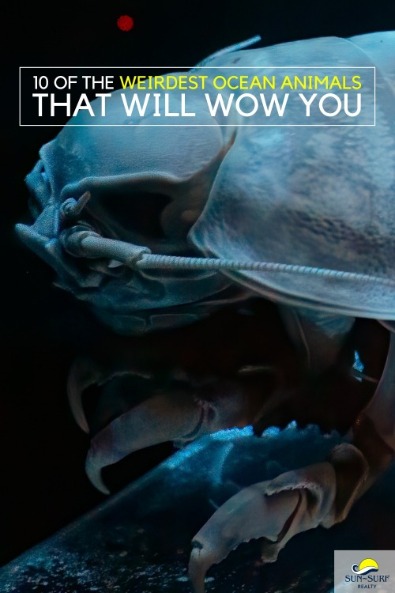
Do you want to see some crazy ocean creatures? We’ve got them! Don’t worry, you won’t see any of these during your Emerald Isle, NC beach vacation. These weird wonders are found in the really deep waters—and it’s probably best that they stay there. If you want to learn more about the aquatic animals of the local area, the North Carolina Aquarium at Pine Knoll Shores is just down the road from your Emerald Isle rental and well worth a visit. Here you can learn more about the amazing aquatic wildlife and coastal habitats of Eastern North Carolina.
Now back to the weird, deep-sea dwellers!
Start by watching this Top 10 weirdest deep sea creatures video.
Check out this short, top 10 video clip of weird looking deep sea creatures to get a good visual—and then read more about each of these ocean dwellers below. There are some crazy creatures near the ocean floor. Check them out!
Now learn more about these unique ocean animals of the deep.
You’ve seen them, now learn more about them! We can all agree that they’re quite unusual but equally fascinating. For simplicity’s sake, we’ll go in the same order that you saw in them in the video.
#10 Giant Ostracod
The giant ostracod is bright orange-red and has two large, mirrored eyes. They look like a shrimp trapped inside a seed pod, so sometimes they’re called seed shrimp. They also resemble an orange pingpong ball floating in the water. Their bodies are hinged like a clam, and they can disappear into their pods with only their antennae showing. When the pod is open, the feather-like antennae stick out to move, feel and feed. The giant ostracod swims by rowing its antennae like oars. You can learn more here.
#9 Anglerfish
Anglerfish live in the murky depths of the Atlantic, but only up to a mile from the surface (thankfully). They have huge heads and crescent-shaped mouths filled with sharp, translucent teeth. Females have a piece of dorsal spine that protrudes above their mouths like a fishing pole tipped with a fleshy lure—hence the name. The males? They parasitically latch onto females with their sharp teeth. Over time, the male physically fuses with the female, connecting to her skin and bloodstream, and losing his eyes and internal organs. A female can carry six or more males on her body at one time. Yeah, that’s pretty creepy. You can learn more here.
#8 Blobfish
The poor blobfish was voted the World’s Ugliest Animal not too long ago and has received a lot of fame ever since. But did you know it doesn’t always look that way? It’s true. Blobfish look like that only when accidentally pulled from the depths and brought above the surface of the water. If left where it belongs, the blobfish looks like a regular ol’ fish just doing its thing on the ocean floor. Once it’s caught in a trawling net, the pressure starts to decrease as the fish is brought up through the waters and begins to lose its shape. You can learn more here.
#7 Frilled Shark
Frilled sharks are sometimes called living fossils because of their prehistoric looks. They are named after the frilly appearance of their gill slits that are lined with a red fringe. They are eel-like and swim in a serpentine fashion through the water. They also have a lot of teeth—twenty-five rows to be exact—amounting to about 300 backward-facing, trident-shaped, extremely sharp teeth. These bottom dwellers rarely come to the surface and were first spotted in their natural habitat in 2004. You can learn more here.
#6 Giant Isopod
Giant isopods look like bugs, but they’re actually crustaceans. They are closely related to terrestrial crustaceans like pillbugs and to marine crustaceans like shrimp and crabs. These bottom-dwellers prefer to burrow into clay and mud. They can get pretty big, reaching over 2 feet in length and come in two different colors: brown and lilac. When they feel threatened, they curl up into a ball just like pillbugs do. Who knew? You can learn more here.
#5 Hatchetfish
Hatchetfish are named such because they are shaped like a hatchet. Masters of camouflage, they have light-producing organs in rows along their bellies. These organs shine a pale blue light that matches daylight filtering down from above and hides them from predators below. Each species of hatchetfish has its own particular pattern of lights. This use of bioluminescent light is called counter-illumination, making hatchetfish almost invisible from below. Pretty cool, right? You can learn more here.
#4 Megamouth Shark
Megamouth sharks are aptly named for their large, circular mouths. This is one of the largest, rarest species of shark in the world and has not been seen by humans very often. These sharks are the smallest of the three filter-feeding sharks, ranking in size behind the whale shark and basking shark.They swim with their mouths constantly wide open in order to filter out their preferred prey. Like many deep-sea species, it is believed that megamouth sharks only come near the surface at night and spend most of their lives in the dark. You can learn more here.
#3 Goblin Shark
Goblin sharks are a species of fish that usually live at the bottom of the ocean along continental shelves. They have narrow snouts and fang-like teeth. Spotted mostly off the coast of Japan, they’re named for their likeness to mythical goblins that appear in Japanese folklore. The most notable feature is the goblin shark’s ability to thrust its jaw three inches out of its mouth, surprising its prey. The jaw of the goblin shark is connected to three-inch-long flaps of skin that can unfold from its snout. After gulping down its meal, the shark retracts its jaw back into its mouth and swims off. You can learn more here.
#2 Viperfish
Viperfish are known for their long, sharp, needle-like teeth. The teeth are so large that they don’t fit inside the mouth of the fish but instead curve back towards its eyes. It is thought that viperfish use these sharp fangs to impale its victims while approaching them at very high speeds. The first vertebrae on the fish is used like a shock absorber. Like many deep sea animals, viperfish use bioluminescence to attract prey with a long dorsal spine tipped with a photophore that acts like a fishing lure. You can learn more here.
#1 Sarcastic Fringehead
The sarcastic fringeheads are fearless, extremely aggressive creatures that charge at anything trying to approach their burrows. The sarcastic part of their name refers to their temperament, and the fringehead part refers to the look of the appendages over their eyes.This species is known for the combative behaviors shown in males when defending their territories. The sarcastic fringehead species is called a tube blenny because they live in burrows or tube-like structures created by other animals. They are found primarily in the North Pacific regions off of the California coast. You can learn more here.
WHAT DO YOU THINK IS THE MOST UNUSUAL DEEP SEA CREATURE ON THIS LIST?
We want to know!

